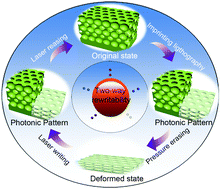Two-way rewritable and stable photonic patterns enabled by near-infrared laser-responsive shape memory photonic crystals†
Abstract
Shape memory photonic crystals (SMPCs), which integrate two distinct scientific areas of photonic crystals and shape-memory polymers, have great potential in advanced optical devices, sensing and displays. Despite recent progress in SMPCs, the contact-stimuli during recovery limit their practical application. Herein, a new type of near-infrared laser-responsive SMPCs is reported. These SMPCs exhibit high optical reversibility, excellent stability, and the direct-pressure-induced programming and near-infrared laser (980 nm)-triggered recovery capabilities, due to the presence of polyurethane units, reversible plastic deformation and the photothermal effect. By taking advantage of these characteristics, various rewritable and stable photonic patterns can be created by imprinting lithography and near-infrared laser writing. Particularly, the photonic membrane exhibits two-way rewritable capability through which the photonic patterns can be created twice in one write/erase cycle. Given the striking color changes associated with the reversible photonic microstructure transitions during programming and recovery, this work provides a facile and versatile platform for multifunctional sensing, displays, and anti-counterfeiting.



 Please wait while we load your content...
Please wait while we load your content...